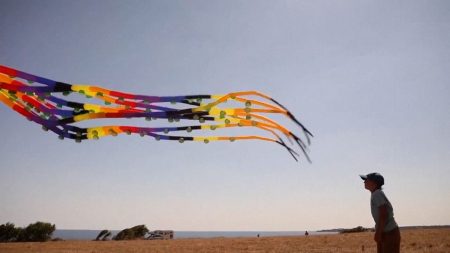The Panda Go! exhibition, a captivating public art display featuring 2,500 miniature panda sculptures, recently charmed the city of Hong Kong. These adorable figures, each uniquely designed and painted, were strategically placed at various iconic locations throughout the city, transforming Hong Kong into a delightful panda paradise. The exhibition drew massive crowds, particularly to the vibrant Victoria Harbour waterfront, where throngs of visitors eagerly sought out the charming panda installations. This public art project, beyond its inherent aesthetic appeal, served as a powerful symbol of conservation, aiming to raise awareness about the plight of endangered giant pandas and their fragile natural habitats. The sheer scale of the exhibition, with thousands of panda figures spread across the city, amplified this message, turning the urban landscape into a giant canvas for promoting wildlife preservation.
The Panda Go! exhibition wasn’t merely a static display; it encouraged active participation and interaction from the public. Visitors were invited to embark on a “panda hunt,” using maps and online resources to locate all 2,500 panda figures scattered across Hong Kong. This interactive element transformed the exhibition into a city-wide scavenger hunt, fostering a sense of community and shared experience as people explored different neighborhoods in search of the elusive panda sculptures. The playful nature of the exhibition resonated with people of all ages, from children captivated by the cute panda designs to adults embracing the spirit of adventure and discovery. This interactive engagement proved crucial in broadening the reach of the exhibition’s core conservation message, making it a fun and memorable experience for all involved.
The choice of Hong Kong as the backdrop for the Panda Go! exhibition held particular significance. As a bustling global metropolis, Hong Kong provided a vibrant and highly visible platform to promote the importance of panda conservation to a vast and diverse audience. The exhibition leveraged the city’s reputation as a cultural hub to draw attention to the plight of these endangered animals. Furthermore, Hong Kong’s strategic location within Asia, a region that is crucial for panda conservation efforts, amplified the exhibition’s impact, raising awareness closer to the pandas’ natural habitats. The Panda Go! exhibition effectively utilized Hong Kong’s urban landscape as a powerful communication tool, transforming the city into a living embodiment of the conservation message.
The 2,500 panda sculptures themselves became miniature ambassadors for wildlife preservation. Each panda figure was individually designed and hand-painted, showcasing a diverse range of artistic styles and interpretations. This artistic diversity not only enhanced the visual appeal of the exhibition but also symbolized the rich biodiversity that is essential for a healthy planet. Moreover, the sheer number of panda figures served as a powerful visual representation of the limited number of giant pandas remaining in the wild, underscoring the urgency of conservation efforts. Each panda sculpture became a tangible reminder of the importance of protecting these vulnerable creatures and their fragile ecosystems.
Beyond the immediate impact of raising awareness, the Panda Go! exhibition also aimed to generate tangible support for panda conservation initiatives. Proceeds from the exhibition, including merchandise sales and donations, were earmarked to support organizations working on the ground to protect giant pandas and their habitats. This direct financial contribution further solidified the exhibition’s commitment to making a real-world difference in panda conservation. The project effectively combined artistic expression with a powerful fundraising component, demonstrating the potential of public art to drive meaningful change and support critical environmental causes.
The success of the Panda Go! exhibition in Hong Kong highlighted the effectiveness of using art and public engagement to promote conservation. By transforming the city into an interactive panda playground, the exhibition captivated audiences, sparking conversations about the importance of protecting endangered species. The project demonstrated the power of public art to transcend cultural boundaries, engage diverse communities, and inspire action. The Panda Go! exhibition served as a powerful reminder that conservation efforts require collective action, and that even seemingly small gestures, like admiring a miniature panda sculpture, can contribute to a larger movement to protect our planet’s biodiversity. The exhibition’s legacy extends beyond the immediate display, inspiring future conservation initiatives and showcasing the potential of art to create positive change in the world.














